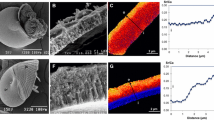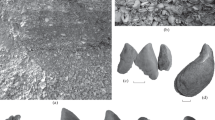Abstract
We report the results of a study with proton-induced X-ray emissions (PIXE) of the distribution and concentration of 15 chemical elements (Na to Sr in periodic chart) in four microstructural and two mineralogical regions of shell of rapidly growing adult oysters [Crassostrea virginica (Gmelin)]. Hatchery-raised oysters were grown in Broadkill Estuary, Delaware, USA, for 16 wk in summer 1978. Their valve edges were filed as a marker, and the oysters were replaced in the estuary, where they grew rapidly. Shell deposited after marking had a normal microstructure and mineralogy after a narrow zone of disturbance. After 17 d oysters were sacrificed, and different mineralogical and microstructural regions of valves of three oysters, and parts of valves of two oysters, were analyzed for the elements Na to Sr. Quadrats (2.5 × 0.45 mm) included three calcitic groups (prismatic, foliated, chalky) and one aragonitic (myostracal) microstructural group; four quadrats were on the exterior and five on the interior of right and left valves. Inhalant and exhalant margins of valves and ground right and left valves of one oyster were also analyzed. Elemental chemistry of different regions of shell varied among the three microstructural groups within the single calcitic polymorph, between aragonitic and calcitic regions, and between exhalant and inhalant margins of the valves. Elements were most concentrated in the prismatic region of the right valve. Element concentrations were similar in ground right and left valves, except for higher levels of Si, Fe, and Zn in the right valve (corresponding to their high contents in prismatic shell) and of Cl in the left valve (reflecting high concentration in chalky shell, abundant in this valve). Na, Mg, Cl, Cr, Cu, Zn and Br were more concentrated in prismatic than in foliated shell. Chalky shell contained higher concentrations of Na than did prismatic shell, and high concentrations (but lower than in prismatic shell) of Mg, Cl, Ti, Mn, Fe, Zn and Br. Element concentration in myostracum was approximately the same as, or lower than, in foliated shell, except for Sr, which was higher than that in any other shell group. In the right valve most elements were concentrated in inhalant margins, and on the left valve, in exhalant margins. With increased weathering of the exterior surface of prismatic shell, Mg, Si, and Mn increased in concentration and Na, Al, Cl, Ti, Cr, Fe, Br, and Sr decreased.
Similar content being viewed by others
Literature cited
Bopp, F. III, Biggs, R. B. (1981). Metals in estuarine sediments: factor analysis and its environmental significance. Science, N.Y. 214: 441–443
Bourgoin, B. P. (1990).Mytilus edulis shell as a bio-indicator of lead pollution: considerations on bioavailability and variability. Mar. Ecol. Prog. Ser. 61: 253–262
Broecker, W. S., Peng, T. H. (1982). Tracers in the sea. Lamont-Doherty Press, Palisades, New York
Carriker, M. R. (1986). Influence of suspended particles on biology of oyster larvae in estuaries. Am. malac. Bull. 3 (spec. ed.): 41–49
Carriker, M. R. (1991). The shell and ligament. In: Eble, A., Kennedy, V. (eds.) Biology, culture, and management of the American oyster. Maryland Office of Sea Grant, College Park (in press)
Carriker, M. R., Palmer, R. E. (1979). A new mineralized layer in the hinge of the oyster. Science, N.Y. 206: 691–693
Carriker, M. R., Palmer, R. E., Prezant, R. S. (1980a). Functional ultramorphology of the dissoconch valves of the oysterCrassostrea virginica. Proc. natn. Shellfish. Ass. 70: 139–183
Carriker, M. R., Palmer, R. E., Sick, L. V., Johnson, C. C. (1980b). Interaction of mineral elements in sea water and shell of oysters (Crassostrea virginica (Gmelin)) cultured in controlled and natural systems. J. exp. mar. Biol. Ecol. 46: 279–296
Carriker, M. R., Swann, C. P., Ewart, J. W. (1982). An exploratory study with the proton microprobe of the ontogenetic distribution of 16 elements in the shell of living oysters (Crassostrea virginica). Mar. Biol. 69: 235–246
Chester, R., Stoner, J. H. (1975). Trace elements in total particulate material from surface seawater. Nature, Lond. 255: 50–51
Ferrell, R. E., Carville, T. E., Martinez, J. D. (1973). Trace metals in oyster shells. Envir. Letters 4: 311–316
Galtsoff, P. S. (1964). The American oyster,Crassostrea virginica Gmelin. Fishery Bull. Fish Wildl. Serv. U.S. 64: 1–480
Imlay, M. (1982). Use of shells of freshwater mussels in monitoring heavy metals and environmental stresses: a review. Malac. Rev. 15: 1–14
Immega, N. T. (1976). Environmental influences on trace element concentrations in some modern and fossil oysters. Ph.D. dissertation, Department of Geology, Indiana University, USA
Loosanoff, V. L., Nomejko, C. A. (1955). Growth of oysters with damaged shell-edges. Biol. Bull. mar. biol. Lab., Woods Hole 108: 151–159
Lorens, R. B., Bender, M. L. (1980). The impact of solution chemistry onMytilus edulis calcite and aragonite. Geochim. cosmochim. Acta 44: 1265–1278
Masuda, F., Hirano, M. (1980). Chemical composition of some modern marine pelecypod shells. Sci. Rep. Inst. Geosci. Univ. Tsukuba (Sec. B) 1: 163–177
Moberly, R. Jr (1968). Composition of magnesian calcites of algae and pelecypods by electron microprobe analysis. Sedimentology 11: 61–82
Nakahara, H., Bevelander, G. (1970). An electron microscope study of the muscle attachment in the molluscPinctada radiata. Texas Rep. Biol. Med. 28: 279–286
Newball, S., Carriker, M. R. (1983). Systematic relationship of the oystersCrassostrea rhizophorae andC. virginica: a comparative ultrastructural study of the valves. Am. malac. Bull. 1: 35–42
Palmer, R. E., Carriker, M. R. (1979). Effects of cultural conditions on morphology of the shell of the oysterCrassostrea virginica. Proc. natn. Shellfish. Ass. 69: 58–72
Phillips, D. J. H. (1980). Quantitative aquatic biological indicators: their use to monitor trace metal and organochlorine pollution. Applied Science Publishers, London
Rosenberg, G. D. (1980). An ontogenetic approach to the environmental significance of bivalve shell chemistry. In: Rhoads, D. C., Lutz, R. A. (eds.) Skeletal growth of aquatic organisms, biological records of environmental change. Plenum Press, New York, p. 133–168
Simkiss, K. (1983). Trace elements as probes of biomineralization. In: Westbroek, P., de Jong, E. W. (eds.) Biomineralization and biological metal accumulation. Biological and geological perspectives. D. Reidel Publishing Co., Boston, p. 363–371
Tompa, A., Watabe, N. (1976). Ultrastructural investigation of the mechanism of muscle attachment to the gastropod shell. J. Morph. 149: 339–352
Turekian, K. K., Armstrong, R. L. (1960). Magnesium, strontium, and barium concentrations and calcite-aragonite ratios of some recent molluscan shells. J. mar. Res. 18: 133–151
Wada, K., Fujinuki, T. (1976). Biomineralization in bivalve molluscs with emphasis on the chemical composition of the extrapallial fluid. In: Watabe, N., Wilbur, K. M. (eds.) The mechanisms of mineralization in the invertebrates and plants. University of South Carolina Press, Columbia, p. 175–190
Wada, K., Suga, S. (1976). The distribution of some elements in the shell of freshwater and marine bivalves by electron microprobe analysis. Bull. natn. Pearl Res. Lab. 20: 2219–2240
Wilbur, K. M. (1964). Shell formation and regeneration. In: Wilbur, K. M., Yonge, C. M. (eds.) Physiology of the Mollusca, Vol. 1. Academic Press, New York, p. 243–282
Wilbur, K. M. (1972). Shell formation in mollusks. In: Florkin, M., Scheer, B. T. (eds.) Chemical zoology. Academic Press, New York, p. 103–143
Wilbur, K. M., Saleuddin, A. S. M. (1983). Shell formation. In: Saleuddin, S. M., Wilbur, K. M. (eds.) The Mollusca, Vol. 4, Physiology, Part 1. Academic Press, New York, p. 235–287
Author information
Authors and Affiliations
Additional information
Communicated by J. Grassle, New Brunswick
Rights and permissions
About this article
Cite this article
Carriker, M.R., Swann, C.P., Prezant, R.S. et al. Chemical elements in the aragonitic and calcitic microstructural groups of shell of the oysterCrassostrea virginica: A proton probe study. Mar. Biol. 109, 287–297 (1991). https://doi.org/10.1007/BF01319397
Accepted:
Issue Date:
DOI: https://doi.org/10.1007/BF01319397




